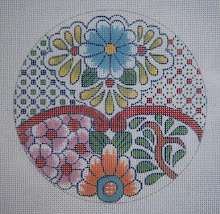 Learning to create and then stitch a plaid is one thing - knowing how to set one up for a project is another. I decided to do an egg with an initial on it - but it's been a while, so I made a few mistakes, which I'll show anyway. Errors in judgment. "Haste is the enemy of perfection" etc.
Learning to create and then stitch a plaid is one thing - knowing how to set one up for a project is another. I decided to do an egg with an initial on it - but it's been a while, so I made a few mistakes, which I'll show anyway. Errors in judgment. "Haste is the enemy of perfection" etc. I decided it needed an oval with the initial - but I miscounted when drawing it on, and it is quite lopsided. On this first picture, I had painted it out and re-drawn it.
Anyway, I consulted, again, my favorite little book on letters - the French book I bought at The NeedleWorks here in Austin.
 (Colleen keeps this one in stock, and will gladly sell you one if you contact her.)
(Colleen keeps this one in stock, and will gladly sell you one if you contact her.) A word here about the charts in these books - they are, of course, graphed, and intended for cross stitch - but I have used them for many years for needlepoint, as all one has to do to translate is to make a tent stitch for every little square instead of a cross stitch as you would on fabric. Quite simple.
 I wanted to put the initial into an oval, so the first thing to do, after I drew (stitch counted for symmetry) the egg outline, was to sketch an oval on tracing paper, ink it when it looked right, and then put it under the egg on canvas.
I wanted to put the initial into an oval, so the first thing to do, after I drew (stitch counted for symmetry) the egg outline, was to sketch an oval on tracing paper, ink it when it looked right, and then put it under the egg on canvas.
It was centered on an even count, as I wanted to outline it in Smyrna crosses for a different effect with pearl cotton. Then, the letter was centered on the oval - which was done with a DecoColor paint pen in green. The next thing was to "size" the checks I originally wanted to use - scale is very important on a specific piece, and using tiny little narrow stripes wouldn't look right - so I settled on four threads wide. Then - decided just a plain gingham would be boring, so I did the four thread pink stripes, but put six threads of white, split by two threads of light green in the center - thus creating an actual "tartan."
The next thing was to "size" the checks I originally wanted to use - scale is very important on a specific piece, and using tiny little narrow stripes wouldn't look right - so I settled on four threads wide. Then - decided just a plain gingham would be boring, so I did the four thread pink stripes, but put six threads of white, split by two threads of light green in the center - thus creating an actual "tartan."
I made the marks with the Sharpie paint pens so they're easy to work on. By doing this, you can see how a plaid develops, as you add and substract the number of threads - and add more colors if you wish. At this point, you'll start noticing plaids everywhere you go!! - and figuring out how you'd work them into a needlepoint project.
One thing I failed to mention - that you can see in this last picture, is that I made a decision to center the pink stripe. I made a sketch to scale on drawing paper first, and placed the canvas over it - adjusted it to see which would be most effective as the center motif. If you count them, you can see that there are seven pink stripes (including the very edges) and six of the white/green/white stripes. As pink is the predominant and stronger color, I wanted to use the format of 7.

Hi, I'm a new blogger with a similar site and was wondering if you would be interested in a link exchange? You can check out my site at www.abouteggring.com. Feel free to email me at derekmlandis@gmail.com if you are interested. Thanks!
ReplyDelete